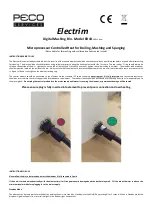
USER’S MANUAL
-
9
-
Chapter 3 SAFETY
It is extremely important to read this chapter of the
manual carefully and from beginning to end as it
contains important information regarding the risks the
operator or maintenance fitter may be exposed to if the
lift is used incorrectly.
In the following text there are clear explanations
regarding certain situations of risk or danger that may
arise during the operation or maintenance of the lift, the
safety devices installed and the correct use of such
systems, residual risks and operative procedures to use
(general and specific precautions to eliminate potential
hazards).
WARNING:
The lifts are designed and built to lift vehicles and hold
them in the elevated position in an enclosed workshop.
All other uses of the lifts are unauthorized. In particular,
the lifts are not suitable for:
●
Washing and respray work;
●
Creating raised platforms for personnel or lifting
personnel;
●
Use as a press for crushing purposes;
●
Use as elevator;
●
Use as a lift jack for lifting vehicle bodies or changing
wheels.
During lifting and lowering movements the operator must
remain in the control station as defined in Fig. 13.
The presence of persons beneath the cross-pieces and/or
the platforms when they are moving, or the presence of
persons inside the danger zone indicated in Fig. 13 is
strictly prohibited.
The area occupied from the lift and perimetral band of
width 1÷2 mt of the lift are defined as "DANGER
ZONE".
The operator parking area, only for actioning the lift, is
defined as "ZONE OPERATOR".
Fig. 13
During operations persons are admitted to the area
beneath the vehicle only when the vehicle is already in
the elevated position, when the cross-pieces and platforms
are stationary, and when the mechanical safety devices
(wedges) are firmly engaged in the slots on the safety
rods.
DO NOT USE THE LIFT WITHOUT PROTECTION
DEVICES OR WITH THE PROTECTION DEVICES
INHIBITED.
FAILURE
TO
COMPLY
WITH
THESE
REGULATIONS CAN CAUSE SERIOUS INJURY TO
PERSONS, AND IRREPARABLE DAMAGE TO THE
LIFT AND THE VEHICLE BEING LIFTED.
GENERAL PRECAUTIONS
The operator and the maintenance fitter are required to
observe the prescriptions of safety regulation in force in the
country of installation of the lift.
Furthermore, the operator and maintenance fitter must:
●
Always work in the stations specified and illustrated
in this manual;
●
Never remove or deactivate the guards and
mechanical, electrical, or other types of safety
devices;
●
Read the safety notices placed on the machine and the
safety information in this manual.
In the manual all safety notices are shown as follows:
Summary of Contents for TFA4500-3D
Page 2: ......
Page 4: ...USER S MANUAL ii...
Page 7: ...USER S MANUAL 3 Chapter 2 SPECIFICATIONS 2 1 OVERALL DIMENSION TFA4500 3D...
Page 8: ...USER S MANUAL 4 TFA5000 3D...
Page 9: ...USER S MANUAL 5 TFA5500 3D...
Page 10: ...USER S MANUAL 6 TFL5000 3D...
Page 31: ...USER S MANUAL 27 APPENDIX B HYDRAULIC DIAGRAM...
Page 32: ...USER S MANUAL 28 APPENDIX C ELECTRICAL WIRING DIAGRAM C 1 380V ELECTRICAL WIRING DIAGRAM...
Page 33: ...USER S MANUAL 29 C 2 220V ELECTRICAL WIRING DIAGRAM...
Page 35: ...USER S MANUAL 31 EXPLOSIVE DIAGRAM...
Page 36: ...USER S MANUAL 32...
Page 37: ...USER S MANUAL 33...














































